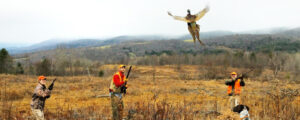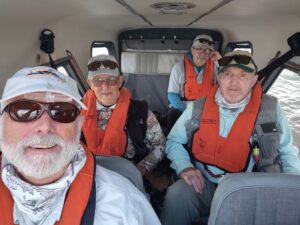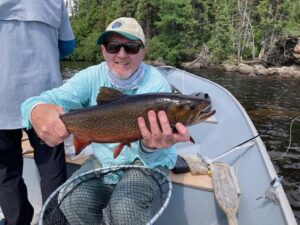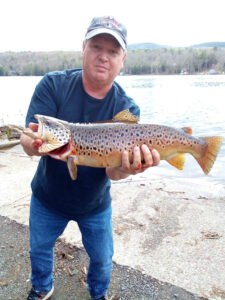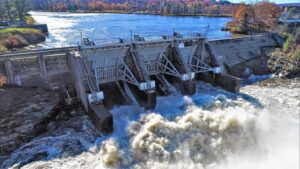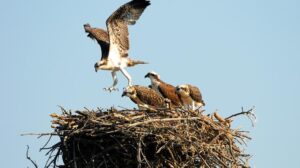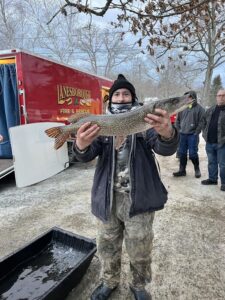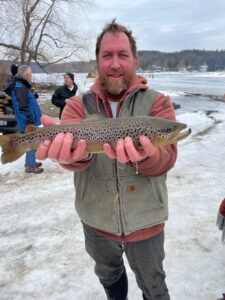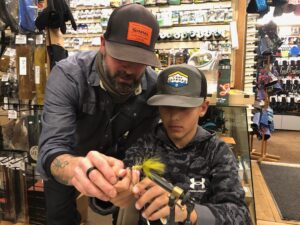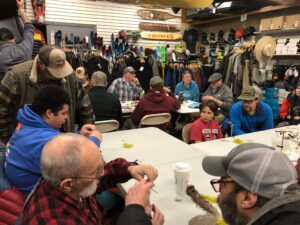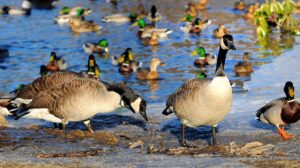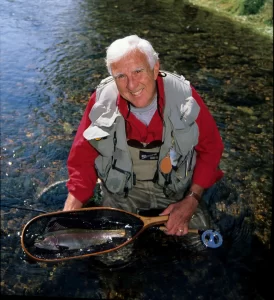Readers may recall an article I wrote on June 24 entitled “Back to Battle on flyfishing trip to the Catskill” which chronicled a fishing trip my buddy Paul Knauth of Hinsdale and I took in early June. You may recall that I couldn’t land any of the large brown trout that I hooked, especially one that Paul described as “looking like a submarine” chasing my fly. I hooked it twice during that trip, but for one reason or another was unable to land, or even see it.
After considerable arm twisting by Paul, we went back to the Catskills in early September, with the intent of having another chance at catching that big trout, assuming that it was still swimming around in the Little Beaverkill River.
We arrived Sunday afternoon, and after checking in at the Roscoe Motel in Roscoe, NY, we suited up and were on the river for the evening hatch. Paul fished upstream where he had good luck in June and I snuck into the spot where I had done battle with that big “submarine.” Other than a few small trout jumping in a riffle nearby, it was quiet. Eventually, I saw a rise near where I thought the big fish lived. I tossed a Cream Cahill dry fly and while I was stripping it in, a nice trout hit it and immediately broke me off. Just as I pulled in, the trout hit and the force of both caused the tippet to snap. Oh no, not again! That could have been the big guy! Paul had come back and witnessed the whole thing.
I half- heartedly made a few more casts afterward thinking that fishing was all over in that hole when, to my delight, another big fish rose and made a decent splash. It refused all my offerings of various flies. Finally, I decided to put on a fly called “The Usual” This old-time fly is made up entirely of the fur from the foot of a snowshoe hare There are oils in that fur which enables the fly to float like a cork.
Just before darkness set in, I tossed it out and after it had completed its drift and began to swing, I felt a heavy tug and the reel began to sing (expression used to describe the reel drag clicking sound). “This is a big fish.” It may be the big one!” I shouted to Paul. The fish headed for the bottom, shaking its head and then ran about 20 feet causing the tip on my rod to bounce up and down. No way I could budge it. Then it took off again stripping more line from my reel and repeating the head shaking. Suddenly, there was no tension on my rod. “You’ve got to be…..!” Thinking it broke my leader, I reeled in the line but it and the fly were intact. The fish must have rubbed its jaw on something and was able to dislodge the fly with a barbless hook, just like the big one did in the spring.
When we returned to the motel that night, there were three other anglers who we met earlier in the day sitting in the walkway outside their rooms. We told them about the big fish and the possibility that it was the same fish missed twice earlier in the spring. It was their opinion based, upon the estimated size, location, where it’s lie was and how it reacted when it was hooked, that it probably was the same fish that cleaned my clock twice in the spring.
The next morning, we fished another area and I was able to catch a nice brown trout using a bamboo rod and fishing with my favorite dry fly, the AuSable Wulff. It was a difficult place to fish and when I reached for my net, I discovered that it was gone. Somewhere, while fighting my way through multiflora roses, etc., the net was pulled off the retractable cord. That meant that without breaking my bamboo rod, I had to carefully bring the trout to my feet so that I could release it without removing it from the water, which I did. (Readers may recall that I broke another bamboo rod last spring). Paul found the net on our way back to the car.
That evening, we returned to where the big, “submarine” lived. There were some small trout jumping after insects, but I didn’t fish for them, not wanting to disturb the hole and scare the big fish. I only had one half-hearted tug on my fly that evening. Darkness set in as we left the river and returned to the motel. The guys were there eager to find out if I caught the big fish. After telling them about the one tug, one of the guys commented that the big fish was becoming a legend, quite fitting for these legendary waters.
The next morning, Paul and I fished the Beaverkill River just below Junction Pool, a famous pool where the Little Beaverkill and the Willowemoc Rivers meet. Paul picked up a rainbow trout there but I got skunked.
After a snack and an afternoon rest, we headed out for “you-know-where.” It was comical because as we pulled out of the motel parking lot, the three other anglers lined up, wishing me good luck, and giving me a thumbs up. It was like I was shipping out and going off to war.
This time Paul fished downstream below me and I went to where the big trout lived. Nothing was happening there, not even the small trout. I must have tried a dozen different flies but to no avail. Then I remembered that I hadn’t tried the AuSable Wulff yet. I selected a smaller one tied parachute style that I had bought earlier that day from a flyfishing shop in Roscoe named Trout Town.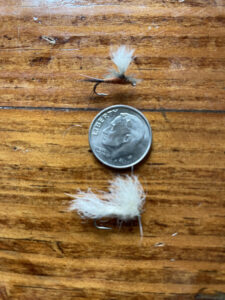
Paul had returned in time to see the horrific splash and my reel starting to scream. “I hooked him again Paul.” I shouted. Shaking its head and staying deep in the water, it kept running and the reel kept screaming – 40, 50, 60 feet of line peeled off of it, and the fish was not slowing down a bit. It became obvious that I might have to follow it when the fly line was nearing the end and I would be into the backing (additional line tied onto the end of the fly line). But that could pose a problem as I was in the river standing on slippery stones, having balance problems and neuropathy in both feet. It continued running, 70, 80 feet without slowing down.
When the 90-foot fly line reached the connection between it and the backing, there was a snag and the line went limp. The fish got off, again!! There was total silence, neither Paul nor I said a word. I finally looked at Paul as if to ask…What just happened here? Paul was looking down at the water with his hands on his knees, perhaps searching for a submarine.
After a long time reeling in the line, I was somewhat relieved to see the fly and leader were still intact. No telling what I would have done if I saw a curlicue at the end of the line which would have indicated an improperly tied knot.
Back at the motel, I was practically speechless and Paul had to relate the story to the others. After receiving their sympathies, they once again re-asserted their opinion that it was the same big trout that harassed me twice in the spring and now three times on this trip. That trout, in their opinion, gained in its already legendary status. In fact Paul suggested that we call it “Iron Mike”, named after the former world heavyweight champion boxer who was one tough, no-nonsense fighter who trained in the Catskills.
The fishing on this trip was generally slow, but thanks to that big trout, and some unique and notable people who we met, it was a memorable trip. I plan to write about them when the opportunity presents itself.
On the way home, Paul urged me to go back after it again this fall. But after beating me 5 times, I wanted to leave it alone to, hopefully, enjoy a long and happy life, which it deserves.
Anyways, it provided immense pleasure at a time when I really needed it. I wish I had at least seen that fish, bade it touché, and shook its fin.
So true, that old saying, “Some of the most memorable fish are the ones that we don’t catch.”

